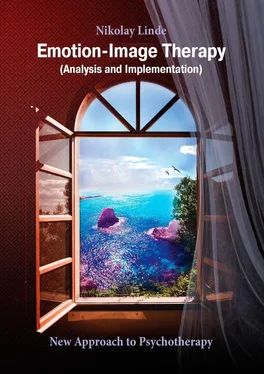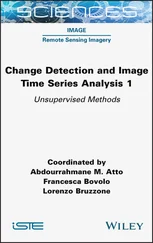It is useful to repeat to the client: “Don’t try. The first thing that occurred to you will do”. It is desirable that an image appeared spontaneously, the very first image is the most correct, though it may seem absurd to the client. If a client is thinking too long, you may suspect that he suppresses the image that appeared initially and tries to think of something “better”. Then the image may be fake and express the resistance of the client to the therapy. But can also be used to establish the truth. For example, you can ask the client to tell that “forced” image to reveal its true potential. You can ask the client what he tries to hide with the help of this image.
If a client assures you that “he is not able to see anything”, a simple means practically always helps. Ask him to stretch his hands in front of him to imagine that the image is on the chair and to tell what it is like to the touch: big or small, hot or cold, soft or hard and so on. Then a visual image emerges easily. If a client definitely prefers audial system you may ask him at the beginning to hear the sound of his feeling.
I am often asked: “Do you get the client into the trance to make him see images?” No, we deliberately don’t get the client into the trance, do not hypnotize him, we even don’t tune to his representative system as they do in the NLP. We don’t want a person to lose his self-control, to plunge into some unknown depths of the psyche, to submit to us, to refuse his own will… On the contrary, we want the client to be able to reason sensibly, to take decisions, to understand logical conclusions, and to interact with images created by himself independently.
If a client starts to pay attention to his inner state, turns his eyes, so to speak, “with pupils looking into his soul”, creates spontaneous images, he himself involuntarily enters the necessary for him trance or remains in his usual state. The state of trance [or the changed state] is the state when the client is extremely attentive to his inner world, to his own emotions, thoughts and feelings. You should be careful about the client’s trust to the doctor and to himself, you should make sure that the client act spontaneously, I mean sincerely and be to some extent relaxed. Even after the first few successful therapeutic methods the trust will increase, spontaneity and the degree of relaxation will grow.
However, a student of mine brings her clients into a meditative state with the help of a special device of audio-visual stimulation. It is not prohibited. It helps to create images even to those clients who are very distant from the subject of emotions and images and are incapable of spontaneity.
5.Image study and problem analysis
Further on an image is studied from the view-point of its sensory characteristics [size, form color and so on], functions [what it does for the subject], attitude [what the subject’s attitude to the image is and what attitude to himself he feels from the image]. For example, the client says: “Well, it is a stone.” I ask: “What kind of stone? Stones are different. Describe in detail.” Then: “And what this stone is doing for you? How it influences you? For what?”
Конец ознакомительного фрагмента.
Текст предоставлен ООО «ЛитРес».
Прочитайте эту книгу целиком, на ЛитРес.
Безопасно оплатить книгу можно банковской картой Visa, MasterCard, Maestro, со счета мобильного телефона, с платежного терминала, в салоне МТС или Связной, через PayPal, WebMoney, Яндекс.Деньги, QIWI Кошелек, бонусными картами или другим удобным Вам способом.












